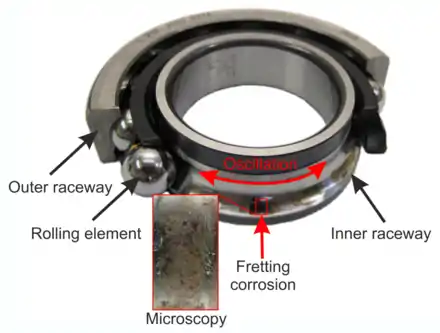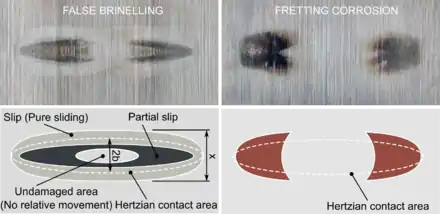Fretting
Fretting refers to wear and sometimes corrosion damage at the asperities of contact surfaces. This damage is induced under load and in the presence of repeated relative surface motion, as induced for example by vibration. The ASM Handbook on Fatigue and Fracture defines fretting as: "A special wear process that occurs at the contact area between two materials under load and subject to minute relative motion by vibration or some other force." Fretting tangibly degrades the surface layer quality producing increased surface roughness and micropits, which reduces the fatigue strength of the components.
The amplitude of the relative sliding motion is often in the order from micrometers to millimeters, but can be as low as 3 nanometers.[1]
The contact movement causes mechanical wear and material transfer at the surface, often followed by oxidation of both the metallic debris and the freshly exposed metallic surfaces. Because the oxidized debris is usually much harder than the surfaces from which it came, it often acts as an abrasive agent that increases the rate of fretting.

The distinction between false brinelling and fretting corrosion has been extensively discussed in the literature.[2][3] The main difference is that false brinelling occurs under lubricated and fretting under dry contact conditions. Between false brinelling and fretting corrosion also exists a time-dependent connection.[4]

Steel
Fretting damage in steel can be identified by the presence of a pitted surface and fine 'red' iron oxide dust resembling cocoa powder. Strictly this debris is not 'rust' as its production requires no water. The particles are much harder than the steel surfaces in contact, so abrasive wear is inevitable; however, particulates are not required to initiate fret.
Products affected
Fretting examples include wear of drive splines on driveshafts, wheels at the lug bolt interface, and cylinder head gaskets subject to differentials in thermal expansion coefficients.
There is currently a focus on fretting research in the aerospace industry.[5] The dovetail blade-root connection and the spline coupling of gas turbine aero engines experience fretting.[6]
Another example in which fretting corrosion may occur are the pitch bearings of modern wind turbines, which operate under oscillation motion to control the power and loads of the turbine.[7]
Fretting can also occur between reciprocating elements in the human body. Especially implants, for example hip implants, are often affected by fretting effects.[8][9]
Fretting electrical/electronic connectors
Fretting also occurs on virtually all electrical connectors subject to motion (e.g. a printed circuit board connector plugged into a backplane, i.e. SOSA/VPX). Commonly most board to board (B2B) electrical connectors are especially vulnerable if there is any relative motion present between the mating connectors. A mechanically rigid connection system is required to hold both halves of a B2B motionless (often impossible). Wire to board (W2B) connectors tend to be immune to fretting because the wire half of the connector acts as a spring absorbing relative motion that would otherwise transfer to the contact surfaces of the W2B connector. Very few exotic B2B connectors exist that address fretting by: 1) incorporating springs into the individual contacts or 2) using a Chinese finger trap design to greatly increase the contact area. A connector design that contacts all 4-sides of a square pin instead of just one or 1 or 2 can delay the inevitable fretting some amount. Keeping contacts clean and lubricated also offers some longevity.
Contact fretting can change the impedance of a B2B connector from milliohms to ohms in just minutes when vibration is present. The relatively soft and thin gold plating used on most high quality electrical connectors is quickly worn through exposing the underlying alloy metals and with fretting debris the impedance rapidly increases. Contrary to common sense, high contact forces on the mated connector pair (thought to help lower impedance and increase reliability) can actually make the rate of fretting even worse.
Fretting fatigue
Fretting decreases fatigue strength of materials operating under cycling stress. This can result in fretting fatigue, whereby fatigue cracks can initiate in the fretting zone. Afterwards, the crack propagates into the material. Lap joints, common on airframe surfaces, are a prime location for fretting corrosion. This is also known as frettage or fretting corrosion.[10]
Factors affecting fretting
Fretting resistance is not an intrinsic property of a material, or even of a material couple. There are several factors affecting fretting behavior of a contact:[11]
- Contact load
- Sliding amplitude
- Number of cycles
- Temperature
- Relative humidity
- Inertness of materials
- Corrosion and resulting motion-triggered contact insufficiency
Mitigation
The fundamental way to prevent fretting is to design for no relative motion of the surfaces at the contact. Surface roughness plays an important role as fretting normally occurs by the contact of the asperities of the mating surfaces. Lubricants are often employed to mitigate fretting because they reduce friction and inhibit oxidation.
Soft materials often exhibit higher susceptibility to fretting than hard materials of a similar type. The hardness ratio of the two sliding materials also has an effect on fretting wear.[12] However, softer materials such as polymers can show the opposite effect when they capture hard debris which becomes embedded in their bearing surfaces. They then act as a very effective abrasive agent, wearing down the harder metal with which they are in contact.
See also
- Tribology – The science and engineering of interacting surfaces in relative motion
- Motion-triggered contact insufficiency
- Wear – Damaging, gradual removal or deformation of material at solid surfaces
- Contact mechanics – Study of the deformation of solids that touch each other
References
- ASM Handbook, Vol. 13 "Corrosion", ASM International, 1987.
- Godfrey, Douglas (2003). "Fretting corrosion or false brinelling?" (PDF). Ribology and Lubrication Technology. 59 (12): 28–31. Retrieved 2017-06-23.
- Errichello, Robert (2004). "Another perspective: false brinelling and fretting corrosion". Tribology & Lubrication Technology. 60 (4): 34–36. Retrieved 2017-06-23.
- Schwack, Fabian. "Time-dependet analyses of wear in oscillting bearing applications". STLE. 72nd. Retrieved 2017-06-23.
- Rao, D. Srinivasa; Krishna, L. Rama; Sundararajan, G. (2017). "Detonation Sprayed Coatings for Aerospace Applications". Aerospace Materials and Material Technologies. Indian Institute of Metals Series. Springer, Singapore. pp. 483–500. doi:10.1007/978-981-10-2134-3_22. ISBN 978-981-10-2133-6.
- Govindarajan Narayanan (2016-10-03). "Effect of sliding friction on spline surface failure under misaligned condition in aero engines". International Journal of Structural Integrity. 7 (5): 617–629. doi:10.1108/IJSI-07-2015-0024. ISSN 1757-9864.
- Schwack, Fabian (2016). "Comparison of Life Calculations for Oscillating Bearings Considering Individual Pitch Control in Wind Turbines". Journal of Physics: Conference Series. 753 (11): 112013. Bibcode:2016JPhCS.753k2013S. doi:10.1088/1742-6596/753/11/112013. Retrieved 2016-03-23.
- Molloy, Dennis O.; Munir, Selin; Jack, Christopher M.; Cross, Michael B.; Walter, William L.; Walter, William K. (2014-03-19). "Fretting and corrosion in modular-neck total hip arthroplasty femoral stems". The Journal of Bone and Joint Surgery. American Volume. 96 (6): 488–493. doi:10.2106/JBJS.L.01625. ISSN 1535-1386. PMID 24647505.
- Brown, L; Zhang, H; Blunt, L; Barrans, S (2007-08-01). "Reproduction of fretting wear at the stem—cement interface in total hip replacement" (PDF). Proceedings of the Institution of Mechanical Engineers, Part H: Journal of Engineering in Medicine. 221 (8): 963–971. doi:10.1243/09544119JEIM333. ISSN 0954-4119. PMID 18161257. S2CID 7918311.
- Charles Lipson, Lester Vern Colwell; Handbook of mechanical wear: wear, frettage, pitting, cavitation, corrosion; University of Michigan Press, 1961; p. 449.
- Aydar, Akchurin. "Fretting, fretting corrosion and fretting mechanisms".
- A. Neyman, O. Olszewski, "Research on fretting wear dependence of hardness ratio and friction coefficient of fretted couple", Wear of materials, International conference No. 9, San Francisco CA, USA (13/04/1993). Wear, vol. 162-64, Part B, pp. 939-943, 1993.
External links
| Wikimedia Commons has media related to Fretting corrosion. |